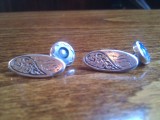CufflinksPosted on 2010/08/08 11:11:44 (August 2010).  [Saturday 7th August 2010] [Saturday 7th August 2010]
Quite a varied day out - went to Portobello market in the morning, and bought a pair of antique cufflinks. Had lunch at a vegetarian Japanese place near King's Cross called Itadaki Zen, then coffee at H R Higgins, and champagne at Fortnum and Mason (this month Taittinger - tasting notes here), before returning home to examine the hallmarks on the cufflinks.
The chap in the market had said the cufflinks were Victorian, and were one of a kind - they had been made specially for the gentleman whose initials were on it - GK. He pointed out the hallmarks - although of course I had no idea what these meant - so when I got home I did a bit of research on the web to try and decipher these.
 The first mark is the standard English silver hallmark - a lion passant gardant. Apparently without this it isn't English silver. The next mark is the city mark for Chester - three wheatsheafs and a sword. It seems there have only ever been about 9 or 10 "assay offices" in the UK, so this doesn't necessarily mean it was made in Chester - this office would have covered a large swathe of the North of England. The third mark is the date mark. It seems these go in cycles, and a subtly different font is used for each cycle. I spent some time poring over charts (see here for example) but it was hard to be 100% sure of the year. It seems most likely from the style of the letter it is in the 1901-1925 cycle. Although this looks more like a 'J' it seems these weren't typically used in each cycle so it is more likely an 'F' (1906) or an 'I' (1909). So it's more likely Edwardian than Victorian, but close enough! The first mark is the standard English silver hallmark - a lion passant gardant. Apparently without this it isn't English silver. The next mark is the city mark for Chester - three wheatsheafs and a sword. It seems there have only ever been about 9 or 10 "assay offices" in the UK, so this doesn't necessarily mean it was made in Chester - this office would have covered a large swathe of the North of England. The third mark is the date mark. It seems these go in cycles, and a subtly different font is used for each cycle. I spent some time poring over charts (see here for example) but it was hard to be 100% sure of the year. It seems most likely from the style of the letter it is in the 1901-1925 cycle. Although this looks more like a 'J' it seems these weren't typically used in each cycle so it is more likely an 'F' (1906) or an 'I' (1909). So it's more likely Edwardian than Victorian, but close enough!
 On the other cufflink just two of the three hallmarks appear (no city mark) - looking at pictures of hallmarks on cufflinks on the web this seems pretty common. On the other cufflink just two of the three hallmarks appear (no city mark) - looking at pictures of hallmarks on cufflinks on the web this seems pretty common.
 This is the maker's mark, which I think is the earlier of two marks used by Charles Horner of Halifax. The original Charles Horner died in 1896, after which the business was carried on by his sons (one of which was also a Charles) - so it seems likely to have been made while Charles Jr. and his brother James were running the business. This is the maker's mark, which I think is the earlier of two marks used by Charles Horner of Halifax. The original Charles Horner died in 1896, after which the business was carried on by his sons (one of which was also a Charles) - so it seems likely to have been made while Charles Jr. and his brother James were running the business.
| Post a comment |

